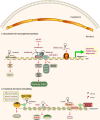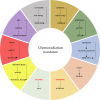LncRNAs, the Molecules Involved in Communications With Colorectal Cancer Stem Cells
- PMID: 35155247
- PMCID: PMC8829571
- DOI: 10.3389/fonc.2022.811374
LncRNAs, the Molecules Involved in Communications With Colorectal Cancer Stem Cells
Abstract
Colorectal cancer stem cells (CRCSCs) can actively self-renew, as well as having multidirectional differentiation and tumor regeneration abilities. Because the high functional activities of CRCSCs are associated with low cure rates in patients with colorectal cancer, efforts have sought to determine the function and regulatory mechanisms of CRCSCs. To date, however, the potential regulatory mechanisms of CRCSCs remain incompletely understood. Many non-coding genes are involved in tumor invasion and spread through their regulation of CRCSCs, with long non-coding RNAs (lncRNAs) being important non-coding RNAs. LncRNAs may be involved in the colorectal cancer development and drug resistance through their regulation of CRCSCs. This review systematically evaluates the latest research on the ability of lncRNAs to regulate CRCSC signaling pathways and the involvement of these lncRNAs in colorectal cancer promotion and suppression. The regulatory network of lncRNAs in the CRCSC signaling pathway has been determined. Further analysis of the potential clinical applications of lncRNAs as novel clinical diagnostic and prognostic biomarkers and therapeutic targets for colorectal cancer may provide new ideas and protocols for the prevention and treatment of colorectal cancer.
Keywords: cancer stem cell; chemoresistance; colorectal cancer; lncRNA; metastasis; signal pathway.
Copyright © 2022 Fan, Zhang, Wang and Wang.
Conflict of interest statement
The authors declare that the research was conducted in the absence of any commercial or financial relationships that could be construed as a potential conflict of interest.
Figures



Similar articles
-
MicroRNA‑8063 targets heterogeneous nuclear ribonucleoprotein AB to inhibit the self‑renewal of colorectal cancer stem cells via the Wnt/β‑catenin pathway.Oncol Rep. 2021 Oct;46(4):219. doi: 10.3892/or.2021.8170. Epub 2021 Aug 13. Oncol Rep. 2021. PMID: 34396427 Free PMC article.
-
LncRNA-cCSC1 modulates cancer stem cell properties in colorectal cancer via activation of the Hedgehog signaling pathway.J Cell Biochem. 2020 Mar;121(3):2510-2524. doi: 10.1002/jcb.29473. Epub 2019 Nov 3. J Cell Biochem. 2020. PMID: 31680315
-
Cancer Stem Cells in Colorectal Cancer: Implications for Targeted Immunotherapies.J Gastrointest Cancer. 2023 Dec;54(4):1046-1057. doi: 10.1007/s12029-023-00945-0. Epub 2023 May 29. J Gastrointest Cancer. 2023. PMID: 37247115 Review.
-
Tumor stem-like cell-derived exosomal RNAs prime neutrophils for facilitating tumorigenesis of colon cancer.J Hematol Oncol. 2019 Jan 25;12(1):10. doi: 10.1186/s13045-019-0699-4. J Hematol Oncol. 2019. PMID: 30683126 Free PMC article.
-
Non-coding RNAs Functioning in Colorectal Cancer Stem Cells.Adv Exp Med Biol. 2016;937:93-108. doi: 10.1007/978-3-319-42059-2_5. Adv Exp Med Biol. 2016. PMID: 27573896 Review.
Cited by
-
LINC01305 recruits basonuclin 1 to act on G-protein pathway suppressor 1 to promote esophageal squamous cell carcinoma.Cancer Sci. 2023 Nov;114(11):4314-4328. doi: 10.1111/cas.15963. Epub 2023 Sep 13. Cancer Sci. 2023. PMID: 37705202 Free PMC article.
-
CircSTK3 drives the metastasis of colorectal cancer by regulating epithelial-mesenchymal transition.iScience. 2023 Feb 9;26(3):106170. doi: 10.1016/j.isci.2023.106170. eCollection 2023 Mar 17. iScience. 2023. PMID: 36922993 Free PMC article.
-
The Regulatory Functions and the Mechanisms of Long Non-Coding RNAs in Cervical Cancer.Cells. 2022 Mar 29;11(7):1149. doi: 10.3390/cells11071149. Cells. 2022. PMID: 35406713 Free PMC article. Review.
-
Glycosyltransferase-related long non-coding RNA signature predicts the prognosis of colon adenocarcinoma.Front Oncol. 2022 Sep 20;12:954226. doi: 10.3389/fonc.2022.954226. eCollection 2022. Front Oncol. 2022. PMID: 36203430 Free PMC article.
-
The Role of Tumor Stem Cells in Colorectal Cancer Drug Resistance.Cancer Control. 2024 Jan-Dec;31:10732748241274196. doi: 10.1177/10732748241274196. Cancer Control. 2024. PMID: 39215442 Free PMC article. Review.
References
Publication types
LinkOut - more resources
Full Text Sources

